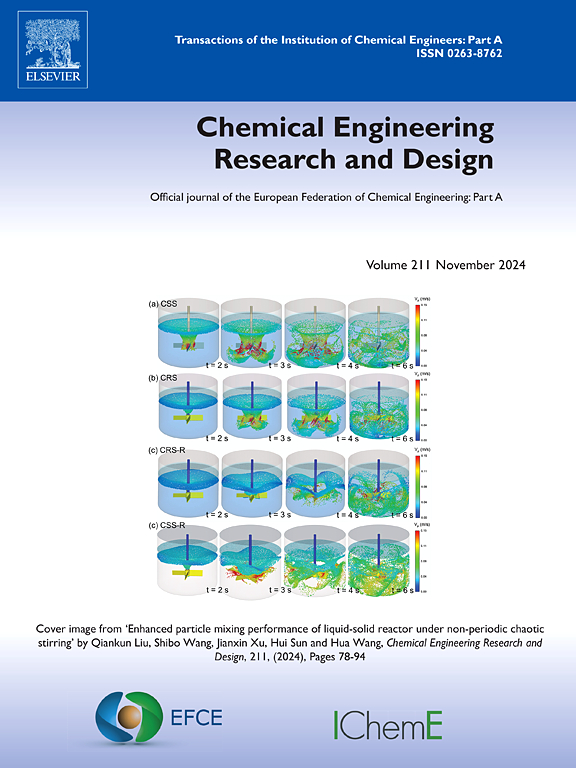Carbon dioxide transport rate in a stirred and sparged tank: Stirring speed and gas flow rate influences
IF 3.7
3区 工程技术
Q2 ENGINEERING, CHEMICAL
引用次数: 0
Abstract
Gas-liquid transport rate of CO2 in a stirred and sparged tank reactor has been studied. The volumetric mass transfer coefficient kLa has been determined by a dynamic method of both CO2 absorption and desorption. The kLa values obtained by both techniques, absorption and desorption, present small differences, although the data obtained by desorption are more reliable and less error. The influences of the stirring speed (values from 100 to 700 rpm) and the gas flow rate (value of 0.1, 0.5 and 1 L/min) have been analyzed. The measurements were carried out by controlling the pH value or by letting its value evolve with the CO2 absorption. For the calculations of the volumetric carbon dioxide mass transfer coefficient, the concentrations of the different species formed when CO2 is dissolved in water were taken into account. Experimental values of the volumetric mass transfer coefficient for CO2 as a function of stirring speed and gas flow rate were fitted and an empirical equation for kLa prediction is proposed. Moreover, values of the volumetric mass transfer coefficient for O2 have been determined in the same reactor under the identical conditions, obtaining also an empirical equation. The comparison of the volumetric mass transfer coefficients for both CO2 and O2 is discussed. In general, the results achieved are in agreement with the few data previously published.
二氧化碳在搅拌和喷射槽中的输送速率:搅拌速度和气体流速的影响
研究了CO2在搅拌喷射罐式反应器中的气液输运速率。用CO2吸附和解吸的动态方法测定了体积传质系数kLa。吸收和解吸两种方法得到的kLa值差异不大,但解吸得到的数据更可靠,误差更小。分析了搅拌速度(100 ~ 700 rpm)和气体流速(0.1、0.5和1 L/min)对搅拌效果的影响。测量是通过控制pH值或让其值随二氧化碳吸收而变化来进行的。为了计算体积二氧化碳传质系数,考虑了二氧化碳溶解于水中时形成的不同物种的浓度。拟合了CO2的体积传质系数随搅拌速度和气体流速变化的实验值,并提出了kLa预测的经验方程。此外,在相同的反应器条件下,测定了O2的体积传质系数,得到了经验方程。讨论了CO2和O2的体积传质系数的比较。总的来说,所取得的结果与以前发表的少数数据一致。
本文章由计算机程序翻译,如有差异,请以英文原文为准。
求助全文
约1分钟内获得全文
求助全文
来源期刊

Chemical Engineering Research & Design
工程技术-工程:化工
CiteScore
6.10
自引率
7.70%
发文量
623
审稿时长
42 days
期刊介绍:
ChERD aims to be the principal international journal for publication of high quality, original papers in chemical engineering.
Papers showing how research results can be used in chemical engineering design, and accounts of experimental or theoretical research work bringing new perspectives to established principles, highlighting unsolved problems or indicating directions for future research, are particularly welcome. Contributions that deal with new developments in plant or processes and that can be given quantitative expression are encouraged. The journal is especially interested in papers that extend the boundaries of traditional chemical engineering.
 求助内容:
求助内容: 应助结果提醒方式:
应助结果提醒方式:


